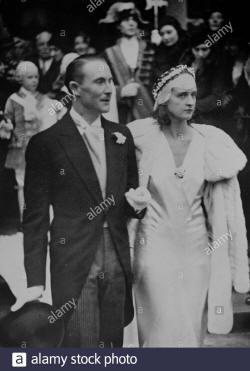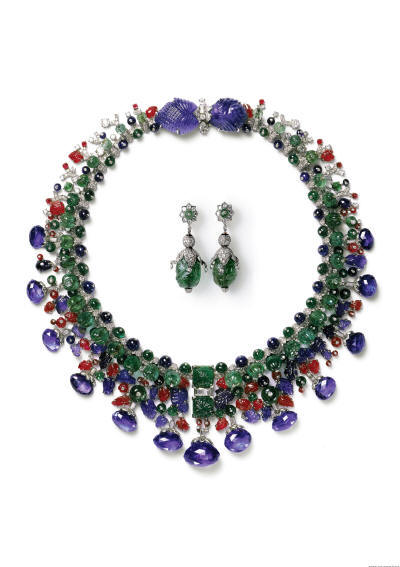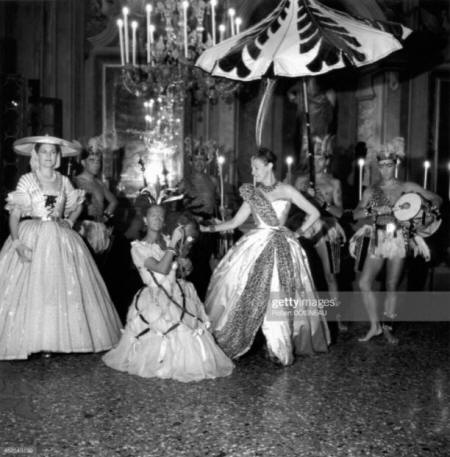

Queer Places:
19 Rue Saint-James, 92200 Neuilly-sur-Seine, France
 Emmeline
"Emma" Isabelle Edmée Séverine de Broglie (February 16, 1911 - September
10, 1986) was a lesbian accused of betraying a girlfriend in the French
Resistance who had been unfaithful to her. Accused of collaboration during World War II, Emmeline de Castéja spent five months in the prison at Fresnes, France.
Emmeline
"Emma" Isabelle Edmée Séverine de Broglie (February 16, 1911 - September
10, 1986) was a lesbian accused of betraying a girlfriend in the French
Resistance who had been unfaithful to her. Accused of collaboration during World War II, Emmeline de Castéja spent five months in the prison at Fresnes, France.
She was born Neuilly, Seine-Saint-Denis, Île-de-France, France, the daughter of Daisy Fellowes and Jean Amédée Marie Anatole de Broglie, Prince de Broglie. In 1932 she married Marie Alexandre William Alvar Biaudos, Comte de Castéja (1907-1983). Her sister are Isabelle de Broglie (1912–1960, novelist, temporarily married to the Marquis de La Moussaye), and Jacqueline de Broglie (1918–1965, temporarily married to Alfred Kraus). Of her own daughters, the notoriously sarcastic Daisy Fellowes claimed: "The eldest is like her father, only a little more masculine. The second is like me, only without courage. The third is from a ghastly little guy named Lischmann."
Alec, Marquis de Castéja, nnd Emmeline de Broglie were living at 19, rue St. James, Neuilly, a suburb of Paris. According to members of the French Resistance Alec de Castéja was a fool. He was arrested as being a De Gaullist and released through intervention by Alfred Kraus. Husband and wife were not in good terms. There was also much jealousy between Miss Elizabeth Rochester and Emma de Castéja; the rumor went that they both had an affair but that eventually Emma transferred her affection to Marie Thion de la Chaume.
Emmeline de Broglie was suspected of working for German Intelligence. However another document in de Castéja's file referring to her brother-in-law Alfred Kraus mentions that she, along with Maximilienne (Baby) Boréa and Madame Thion de la Chaume, were involved in organizing the Resistance in the Lille area. Madame Thion de la Chaume is possibly Marie Madeleine Louise LeBlanc, born in Lille in 1906, who married Robert Thion de la Chaume (1906-1970) in 1938.
She died in Onex, Switzerland.
Cartier’s most famous Tutti Frutti jewel is the impressive Collier Hindou necklace created for (eternally stylish) socialite Daisy Fellowes in 1936. Based off the design of a necklace made for the Maharajah of Patna in 1935, this piece took the form of an elaborate bib done in the traditional Indian style. Very similar to the Maharajah’s piece, which incorporated old- cut diamonds, carved rubies and emeralds, the Collier Hindou was a knot of twisted diamond vines studded with emerald leaves and berries of ruby and sapphire. An unlucky stone in Indian tradition, sapphires were obviously not used in the Maharajah’s collar, but this necklace used them in excess, with borders of sapphire beads along the top and bottom edges and an additional fringe of thirteen faceted stones suspended along the front. Originally fastened on a cord of Indian silk, the necklace could be adjusted to be worn at varying lengths along the neck, but this feature was changed in 1963 when Fellowes’s daughter Emmeline de Casteja had the strings replaced by a continuation of the necklace’s jewelled motif. The Collier Hindou, with a matching pair of carved emerald and diamond earrings, surfaced at auction at Sotheby’s in Geneva in 1991, and was purchased by Cartier for it’s private collection. Sold for $2,655,172.00, the sale set a record price for Cartier’s Tutti Frutti jewels and a price trend that has held on to this very day. Tutti Frutti pieces frequently set records at auction, often surpassing their pre- sale estimates four times over, with bracelet prices exceeding $1 and $2 million mark for notable pieces. Christie’s London has set records twice in the past five years with the sale of two Tutti Frutti bracelets, one going for $1.9 million in 2011 and another for $2.1 million in 2013, while Evelyn Lauder’s famous piece went for over $2.4 million at Sotheby’s in 2014.


VENICE, ITALY - SEPTEMBER 03: Mrs Reginald Fellowes and her daughter Countess Alexandre de Casteja at the ball Besteigui on September 3, 1951 in Venice, Italy. (Photo by Robert DOISNEAU/Gamma-Rapho via Getty Images)
My published books: